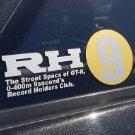Buy, Build & Use A Tech Edge A/f Ratio Meter
Announcements
-
Similar Content
-
Latest Posts
-
Nah, if I need to fit people in a car I'll just use the Mrs car, the MX5 is perfect for what I need as a fun little sports car for fun on the street As for getting in and out of the MX5, I have no issues as I am a short arse who does lots of mobility training 🥷 If anything, I have been looking at Daihatsu Hi-Jets for a work hack, I helped one of my mates move some stuff with one recently that he picked up from Just Jap, it was a little ripper and plenty big enough for what we needed, it would also be super handy for me as I do alot of gardening, and plan on having some veggie patches and native gardens in the place I buy next year when I retire I did alot landscape gardening and growing veggies prior to my current job, and loved it, and that is a hobby that can keep me sane in my retirement, and as such, the little 300kg load capacity would be more than enough for what I need it to move around I have been looking at utes for just this purpose for a while now, and a near new 2024 Hi-Jet can be had for under $30k And I would rather look at a quirky little Hi-Jet than pretty much any other little ute, well, apart from a Brumby, I love the little Brumby, and weirdly have never owned one yet I was going to buy a heap of raffle tickets to try and win the Brumby that MCM built for Subaru Australia, but sadly I totally missed the raffle, I even filled in some form to be told when the raffle started so I could buy tickets, but to my dismay I was never contacted and found out I missed it when I was randomly googling Brumbys last year... #conspiracy Maybe I should just buy a Brumby for a little "work hack".....LOL I use to be indecisive, but now I'm not sure
-
Well.... it's not just "de-oxygenating". If you do that you just have, most likely, ethane. So you still need to do a synthesis step to combine a number of ethanes/ethanols to make circa-8-chain hydrocarbons. And of course you don't want straight chain HCs, because n-octane actually has a negative octane rating (ie, it's worse even than the n-heptane which sets the zero on the octane scale!), so you have to do some tricky catalytic chemistry to synthesise branched HCs. That's all doable - but it doesn't come for free. And.... it starts with ethanol, which is an agricultural product, and there will almost certainly never be enough of that as a base stock to replace the liquid fuels that are in use. You really wouldn't want to be planning to be using any more ethanol for fuels than is currently already used (in E10, E85s, etc). And ideally you'd be looking to reduce such usage, as it is largely wasteful, particularly in the stupid-ole'US-of-A where the corn lobby has organised it so that it's actually primary production corn that is used to make a lot of the ethanol, not by-products and waste, like it is (mostly) elsewhere. So, what I said about needing free-ish energy probably still applies. True synth fuels would be made from H2 and CO2, in a near reversal of the combustion process. In fact, given that the H2 would be split from water first, it actually is a complete reversal of the combustion process. But...energy intensive. The human race burns something like 1 cubic MILE of crude oil, after it has been made into various fuels. Every year. That's a simply stupendous amount of energy. Just assume that the density is 900 kg/m3, and that the calorific value is 45 MJ/kg, then that is 165.9 x10^12 MJ of energy. Or more than 10^19 Joules. You get a maximum of 1 kJ/s per square meter solar radiation falling on the planet's surface, and so if you halve that for daylight, and halve it again for average weather (highly optimistic) and then take ~25% for the very best efficiency of solar panels, then you need about 85.7 billion square metres of solar panels to generate enough electricity to replace that liquid fuel energy consumption. Each panel is about 1m2. That's a rather large number of panels. We also burn about a cubic mile of coal. We also use hydroelectric power. We also use nuclear. We also use a number of other sources, both "renewable" and not. You can kind of ignore the renewable ones (except for hydro, because it will all end up getting subsumed into pumped hydro for storing other renewables, and so it won't be the standalone renewable that it originally was), so we end up needing a multiple of the ground area number that I just arrived at.
-
Corvette thread then? Don't say I didn't predict the future again. "I love the little MX5, I do, but I just want something a little easier to get in/out of, a little more cushy and some power would be nice - I miss the V8 Rumble... I found this clean red C5 for sale recently and..." I'll do you a great deal on the next step, which is one of those but you can fit people in it, too.
-
By joshuaho96 · Posted
What about renewable diesel and/or gasoline? I see some projects spinning up like de-oxygenating ethanol to make drop-in compatible bio-gasoline especially in CA. I still think the future is EVs and we should've all gone full throttle on nuclear power after the 1973 oil crisis like France. Despite 15 years of work in CA to reduce the CO2 intensity of generation with renewables our electric grid is still far worse than even "low carbon" nuclear power. ICE is pretty cool when you aren't depending on the stupid thing to be practical and reliable and cheap as possible to get you to work every day. It's kind of like mechanical watches or vacuum tube amps. -
I just rolled over "my" first 10k km in the MX5 Every time I go anywhere it always ends up in a adventure to look at houses and find some random country roads I've been on leave since early November but unfortunately need to go back to work on 19 January Luckily though I still have a fair chunk of leave left to burn until.... Not that I'm counting 😁
-








Recommended Posts
Create an account or sign in to comment
You need to be a member in order to leave a comment
Create an account
Sign up for a new account in our community. It's easy!
Register a new accountSign in
Already have an account? Sign in here.
Sign In Now